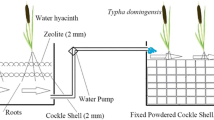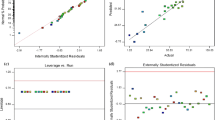Abstract
Environment pollution by heavy metals has been considered as a vital threat to the human health. Current research is aimed to remove chromium(VI) and cadmium from aqueous solutions using the new constructed wetland system. In current study, two fresh and healthy water hyacinths (Eichhornia crassipes) were transplanted to the constructed wetland (CW). CW included four substrate layers of adsorbents, namely BAZLSC and cockle shell. The aqueous solution, and the concentrations of chromium(VI) and cadmium were achieved by dissolving K2Cr2O7 and CdCl2 in tap water, respectively. Afterward, this solution was poured to the CW. Response surface methodology and central composite design were utilized to optimize independent factors, including contact time (24–72 h) and initial concentration of metals (20–80 mg/L), and their responses. Removal efficacy of Cr and Cd was 92.3 and 94.6% at the optimum of react time (48.9 h) and initial concentration of metals (50.9 mg/L). Also, the accumulations of Cr(VI) and Cd in roots and shoots of plants were monitored.
Graphical Abstract





Similar content being viewed by others
References
Akoto O, Ephraim JH, Darko G (2008) Heavy metal pollution in surface soils in the vicinity of abundant railway servicing workshop in Kumasi, Ghana. Int J Environ Res 2(4):359–364
APHA (2005) Standard methods for the examination of water and wastewater, 21st edn. American Public Health Association, Washington DC, p 541
Attia AA, Khedr SA, Elkholy SA (2010) Adsorption of chromium ion (Vi) by acid activated carbon. Braz J Chem Eng 27(01):183–193
Aziz SQ, Aziz HA, Yusoff MS (2011) Optimum process parameters for the treatment of landfill leachate using powdered activated carbon augmented sequencing batch reactor (SBR) technology. Sep Sci Technol 46:1–12
Boparai HK, Joseph M, O’Carroll DM (2011) Kinetics and thermodynamics of cadmium ion removal by adsorption onto nano zerovalent iron particles. J Hazard Mater 186:458–465
Campbell CR, Plank CO (1998) Preparation of plant tissue for laboratory analysis. In: Kalra YP (ed) Handbook of reference method for plant analysis. CRC Press, Boca Raton, FL, pp 37–49
Chakroun HK, Souissi F, Bouchardon JL, Souissi R, Moutte J, Faure O, Remon E, Abdeljaoued S (2010) Transfer and accumulation of lead, zinc, cadmium and copper in plants growing in abandoned mining-district area. Afr J Environ Sci Technol 4(10):651–659
de Bullen PG, **dal R, Tantrakarnapa K (2011) Modeling of cadmium removal from domestic wastewater in constructed wetlands using STELLA simulation program. J Hazard Toxic Radioact Waste 15:114–120
El-Gendy AS, Biswas N, Bewtra JK (2006) Municipal landfill leachate treatment for metal removal using water hyacinth in a floating aquatic system. Water Environ Res 78(9):951–964
Fibbi D, Doumett S, Lepri L, Checchini L, Gonnelli C, Coppini E, Del Bubba M (2012) Distribution and mass balance of hexavalent and trivalent chromium in a subsurface, horizontal flow (SF-h) constructed wetland operating as post-treatment of textile wastewater for water reuse. J Hazard Mater 199(200):209–216
Greger M (1999) Metal availability and bioconcentration in plants. In: Prasad MNV, Hagemeyer J (eds) Heavy metal stress in plants. Springer, Berlin, pp 1–27
Hafeznezami S, Kim JL, Redman J (2012) Evaluating removal efficiency of heavy metals in constructed wetlands. J Environ Eng 138:475–482
Halim AA, Aziz HA, Johari MAM, Ariffin KS, Bashir MJK (2012) Semi-aerobic landfill leachate treatment using carbon–minerals composite adsorbent. Environ Eng Sci 29(5):306–312
Hossini H, Rezaee A, Mohamadiyan G (2015) Hexavalent chromium removal from aqueous solution using functionalized multi-walled carbon nanotube: optimization of parameters by response surface methodology. Health Scope 4(1):e19892
Izanloo H, Nasseri S (2005) Cadmium removal from aqueous solutions by ground pine cone. Iran J Environ Health Sci Eng 2(1):33–42
**dal R, Samorkhom N (2005) Cadmium removal from wastewater in constructed wetlands. Pract Period Hazard Toxic Radioact Waste Manag 9:173–178
Karimi N (2013) Comparative phytoremediation of Chromium-contaminated soils by alfalfa (Medicago sativa) and Sorghum bicolor (L) Moench. Int J Sci Res Environ Sci 1(3):44–49
Lissy AM, Madhu G (2011) Removal of heavy metals from waste water using water hyacinth. ACEEE Int J Transp Urban Dev 1(1):48–52
Maine MA, Sune N, Hadad H, Sanchez G, Bonetto C (2009) Influence of the vegetation on the removal of heavy metals and nutrients in a constructed wetland. J Environ Manag 90:355–363
Manjunatha BR, Balakrishna K, Shankar R, Mahalingam TR (2001) Geochemistry and assessment of metal pollution in soils and river components of a monsoon-dominated environment near Karwar, southwest coast of India. Environ Geol 40:1462–1470
Mant C, Costa S, Williams J, Tambourgi E (2005) Studies of removal of chromium by model constructed wetland. Braz J Chem Eng 22(3):381–387
Mmolawa KB, Likuku AS, Gaboutloeloe GK (2011) Assessment of heavy metal pollution in soils along major roadside areas in Botswana. Afr J Environ Sci Technol 5(3):186–196
Mohan D, Singh KP, Singh VK (2005) Removal of hexavalent chromium from aqueous solution using low-cost activated carbons derived from agricultural waste materials and activated carbon fabric cloth. Ind Eng Chem Res 44:1027–1042
Mojiri A (2014) Co-treatment of landfill leachate and settled domestic wastewater using composite adsorbent in sequencing batch reactor. Ph.D. thesis, University of Science Malaysia
Mojiri A, Aziz HA, Zahed MA, Aziz SQ, Selamat RBM (2013) Phytoremediation of heavy metals from urban waste leachate by southern cattail (Typha domingensis). Int J Sci Res Environ Sci 1(4):63–70
Mojiri A, Aziz HA, Zaman NQ, Aziz SQ, Zahe MA (2014) Metals removal from municipal landfill leachate and wastewater using adsorbents combined with biological method. Desalination Water Treat 57(6):2819–2833
Mojiri A, Ziyang Z, Tajuddin RM, Farraji H, Alifar N (2016) Co-treatment of landfill leachate and municipal wastewater using the ZELIAC/zeolite constructed wetland system. J Environ Manag 166:124–130
Nikagolla C, Chandrajith R, Weerasooriya R, Dissanayake CB (2013) Adsorption kinetics of chromium(III) removal from aqueous solutions using natural red earth. Environ Earth Sci 68:641–645
Okunowo WO, Ogunkanmi LA (2010) Phytoremediation potential of some heavy metals by water hyacinth. Int J Biol Chem Sci 4(2):347–353
Ossman ME, Mansour MS (2013) Removal of Cd(II) ion from wastewater by adsorption onto treated old newspaper: kinetic modeling and isotherm studies. Ossman Mansour Int J Ind Chem 4:13
Parmar K (2013) Removal of cadmium from aqueous solution using cobalt silicate precipitation tube (CoSPT) as adsorbent. IJSIT 2(3):204–215
Peer WA, Baxter IR, Richards EL, Freeman JL, Murphy AS (2005) Phytoremediation and hyperaccumulator plants. The University of Chicago, The Science Behind Genetically Modified Organisms, Chicago, IL, p 43
Sahu O (2014) Reduction of heavy metals from waste water by wetland. Int Lett Nat Sci 12:35–43
Snyder KVW (2006) Removal of arsenic from drinking water by water hyacinths (Eichhornia crassipes). Water Environ Fed. doi:10.2175/SJWP(2006)1:41
Sultana MY, Akratos CS, Pavlou S, Vayenas DV (2014) Chromium removal in constructed wetlands: a review. Int Biodeterior Biodegrad 96:181–190
Swain G, Adhikari S, Mohanty P (2014) Phytoremediation of copper and cadmium from water using water hyacinth, Eichhornia crassipes. Int J Agric Sci Technol 1:1–7
Tangahu BV, Abdullah SRS, Basri H, Idris M, Anuar N, Mukhlisin M (2011) A review on heavy metals (As, Pb, and Hg) uptake by plants through phytoremediation. Int J Chem Eng Article ID 939161
Terfie TA, Asfaw SL (2015) Evaluation of selected wetland plants for removal of chromium from tannery wastewater in constructed wetlands, Ethiopia. Afr J Environ Sci Technol 9(5):420–427
Tilaki D, Ali R (2003) Study on removal of cadmium from water environment by adsorption on Gac, Bac and biofilter. In: Diffuse pollution conference Dublin, 8B Ecology
Wu M, Li Q, Tang X, Huang Z, Lin L, Scholz M (2014) Arsenic(V) removal in wetland filters treating drinking water with different substrates and plants. Int J Environ Anal Chem 94(6):618–638
Yoon J, Cao X, Zhou Q, Ma LQ (2006) Accumulation of Pb, Cu, and Zn in native plants growing on a contaminated Florida site. Sci Total Environ 368:456–464
Acknowledgements
The authors would like to express their gratitude to the Institute of Infrastructure Engineering and Sustainability Management (IIESM), Universiti Teknologi Mara (UiTM) for their supports.
Author information
Authors and Affiliations
Corresponding author
Additional information
Editorial responsibility: J. Aravind
Rights and permissions
About this article
Cite this article
Mojiri, A., Tajuddin, R.M., Ahmad, Z. et al. Chromium(VI) and cadmium removal from aqueous solutions using the BAZLSC/cockle shell constructed wetland system: optimization with RSM. Int. J. Environ. Sci. Technol. 15, 1949–1956 (2018). https://doi.org/10.1007/s13762-017-1561-2
Received:
Revised:
Accepted:
Published:
Issue Date:
DOI: https://doi.org/10.1007/s13762-017-1561-2




